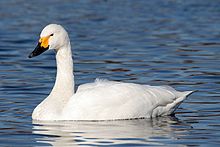
Back Fluitswaan Afrikaans Cygnus columbianus AN تم التندرا Arabic تم التندرا ARZ Azdas loror (Cygnus columbianus columbianus) AVK Amerika qu quşu Azerbaijani Малък лебед Bulgarian Alarc'h c'hwitell Breton Cigne petit Catalan Cygnus columbianus CEB
| Tundra swan (Bewick's swan/whistling swan) | |
|---|---|

| |
| Adult Bewick's swan, Cygnus columbianus bewickii | |
| C.c. beweckii recorded in Gloucestershire, England | |
| Scientific classification | |
| Domain: | Eukaryota |
| Kingdom: | Animalia |
| Phylum: | Chordata |
| Class: | Aves |
| Order: | Anseriformes |
| Family: | Anatidae |
| Genus: | Cygnus |
| Species: | C. columbianus
|
| Binomial name | |
| Cygnus columbianus (Ord, 1815)
| |
| Subspecies[2] | |
|
C. c. bewickii (Yarrell, 1830), Bewick's swan | |

| |
| Synonyms[2] | |
| |
The tundra swan (Cygnus columbianus) is a small swan of the Holarctic. The two taxa within it are usually regarded as conspecific, but are also sometimes[3][4] split into two species: Bewick's swan (Cygnus bewickii) of the Palaearctic and the whistling swan (C. columbianus) proper of the Nearctic. Birds from eastern Russia (roughly east of the Taymyr Peninsula) are sometimes separated as the subspecies C. c. jankowskii, but this is not widely accepted as distinct, with most authors including them in C. c. bewickii. Tundra swans are sometimes separated in the subgenus Olor together with the other Arctic swan species.
Bewick's swan was named in 1830 by William Yarrell after the engraver Thomas Bewick, who specialised in illustrations of birds and animals.[5] Cygnus is the Latin for "swan", and columbianus comes from the Columbia River, the type locality.[6]
- ^ BirdLife International (2016). "Cygnus columbianus". IUCN Red List of Threatened Species. 2016: e.T22679862A89644875. doi:10.2305/IUCN.UK.2016-3.RLTS.T22679862A89644875.en. Retrieved 11 November 2021.
- ^ a b "Cygnus columbianus". Global Biodiversity Information Facility. Retrieved 30 September 2021.
- ^ Cite error: The named reference
Madgewas invoked but never defined (see the help page). - ^ Cite error: The named reference
Rasmussenwas invoked but never defined (see the help page). - ^ Cite error: The named reference
Uglow2006was invoked but never defined (see the help page). - ^ Jobling, James A (2010). The Helm Dictionary of Scientific Bird Names. London: Christopher Helm. pp. 114, 128. ISBN 978-1-4081-2501-4.
